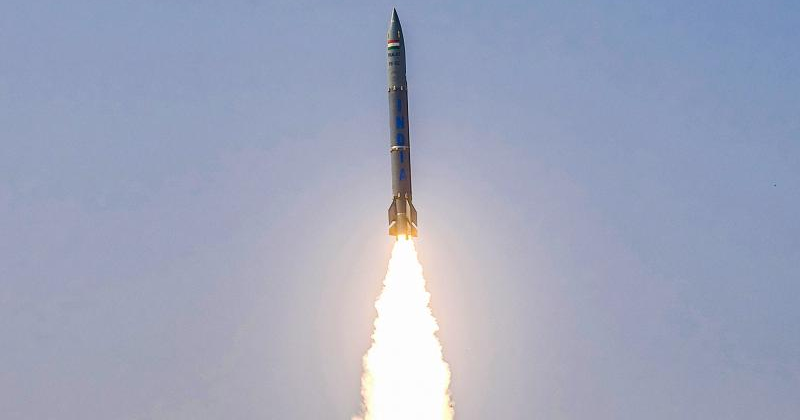The Indian armed forces are now planning to purchase the Pralay ballistic missile, which can hit targets up to 500 kilometres away, amid the ongoing conflict with China. A high-level meeting held a few days ago approved the proposal put forth by the Indian armed forces.
The proposal is also significant because it comes at a time when the Defence Ministry’s highest levels have been discussing the creation of a rocket force by the Indian forces.
Jump To
![]()
More about PRALAY
“Pralay” is powered by solid propellant rocket motors and other cutting-edge technologies, and has a range of 150 to 500 km. While primarily ballistic, a quasi-ballistic missile can manoeuvre while in flight and has a low trajectory. With a 500 kg payload, Pralay will be able to hit a target 400 kilometres away. To combat the Chinese Army’s stationing of the Dongfeng-12 (DF-12) short-range tactical ballistic missile along India’s border, Pralay was developed. The Dongfeng-12 (DF-12) is thought to have a maximum range of 400 kilometres and a range between 100 and 250 kilometres.

PTI
The Pralay missile will play a significant role in the upcoming Rocket Force, which will be raised soon as India’s fourth branch of the armed forces. Pralay (havoc, devastation) will be able to quickly strike and hit important targets inside the enemy camp while also avoiding the air defence system thanks to its non-parabolic trajectory.
Due to its jet vane control system (JVC) and tandem fins, Pralay is able to fly depressed trajectories and vary its flight in the terminal phase. A ballistic missile that flies like a subsonic cruise missile inside the atmosphere but at nearly hypersonic speeds will be difficult for any modern dedicated anti-ballistic missile defence system as well as any air defence system to intercept.
The missile was created domestically by DRDO and is a variant of the enemy weapon-destroying, high-altitude Prithvi Defence Vehicle (PDV) Exo-atmospheric interceptor missile. Pralay, which is more rapid and precise, has a 350- to 500-kilometre strike range and weighs about five tonnes. It can cover a distance of 350 km with a payload of 1,000 kg. According to the Indian Defence News, if the payload is cut in half, the missile will be able to reach a target up to 500 km away.
Similarities With Russia’s Iskander
The Russian military has made extensive use of the NATO-designated SS-26 “Stone” 9K720 Iskander-M short-range ballistic missile (SRBM) during the ongoing conflict with Ukraine.
With a maximum flying range of 310 miles, each launcher vehicle can carry two missiles (nearly 500 kilometres). This shows that Iskander’s range, which it used to strike targets deep inside Ukrainian territory, is comparable to the range of India’s Pralay ballistic missile.

AFP
Iskander has a payload capacity of about 1500 pounds, or more than 680 kilograms. According to earlier reports, it could cover a distance of 350 kilometres with a heavy payload. However, if Pralay’s payload is split in half, the missile can strike a target up to 500 kilometres away.
As a result, the Pralay missile’s range and trajectory parameters are similar to those of the Russian 9K720 Iskander missile. To identify targets, the Iskander missile instead employs an optical Digital Scene Matching Area Correlator (DSMAC).
The DSMAC ensures increased attack precision and is an autonomous missile guidance concept based on area correlation of sensed ground scenes.
According to the Iskander missile in Ukraine, penetration aids (PENAIDs), which take the form of decoys that resemble mortars, are used to trick enemy radars and interceptor missiles.
Significance of Pralay
The missile, which will be the country’s first tactical quasi-ballistic missile, will enable the armed forces to strike strategic installations and enemy positions in actual battle zones. The BrahMos supersonic cruise missile and Pralay will be the main components of India’s proposed Rocket Force, which was envisioned by the late General Bipin Rawat, a former Chief of Defence Staff (CDS). Only conventional missiles would fall under the planned Rocket Force as and when it is ready, according to sources in the defence establishment, while nuclear weapons would continue to fall under the purview of the Strategic Forces Command.

PTI
Former DRDO scientist R.K. Gupta said “Pralay is a game-changer. It will completely change the tactical battlefield dynamics and India will have two conventional missiles with long range. The BrahMos will be a cruise option and this one will be the ballistic option,” he added, as cited by the Indian Defence News.
Both ballistic and cruise missiles have specific advantages. While ballistic missiles have the advantage of speed and can be defended against even by modern air defence systems, cruise missiles have the advantage of high agility, stealth, and even loitering capabilities.
The Pralay missile programme, which is a variation of the Prahaar missile programme, which underwent its first test in 2011, was sanctioned in 2015. Since a longer range was desired, that missile has not yet been introduced.


